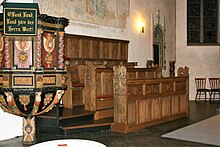Apostle Church (Herscheid)
The Evangelical Apostle Church is a listed church building in Herscheid , a municipality in the Märkisches Kreis in North Rhine-Westphalia .
History and architecture
The church was originally dedicated to St. Dedicated to Cyriacus . She was first mentioned in a document as Herisceithe in a deed of donation from King Ludwig the child to the Kaiserswerth Abbey in 904 . Archbishop Anno II of Cologne transferred various churches and towns to the Grafschaft monastery in 1072, including Hertsceido .
The squat hall church with an indicated two-aisled transept and a einjochigen Choir with 5/8 Final was from dry stone masonry and plastered. The nave and the western transept were built in the second half of the 13th century. The east transept with the one-bay chapel extension on the north arm, the choir and the north sacristy were built at the end of the 13th or beginning of the 14th century. The south aisle was redesigned Gothic . The two side aisles are the same height as the central nave. The church was extensively restored after a village fire in 1686. The west tower is of stately wall thickness. In the north aisle, barrel vaults were pointed , otherwise ridge vaults were drawn in. Niches are worked into the pillars of the eastern transept. The star and rosette patterns of the keystones as well as the seven star pattern in the keystone above the altar are remarkable.
The church was badly damaged in attacks during World War II in 1945 and restored from 1947 to 1950. The interior was extensively renovated from 1969 to 1971 and 1994. During the first renovation, the foundations of a former small apse were excavated, which in the 15th century had to give way to the large choir in its current form.
The many alterations made buttresses necessary; these have recently been provided with a concrete corset; the anchors previously required in the choir could be removed.
Furnishing
- A medieval altar block. The late Gothic carved altar is in the Altena Castle Museum .
- The pulpit was made at the end of the 17th century.
- The choir stalls with flat carvings are marked 1548.
- The baroque organ front was installed at the end of the 17th century, the base is from 1971.
- The ten apostles were painted around 1720.
- There are still remnants of the baroque furnishings, such as parts of the altar, stalls and gallery .
organ
The organ in the baroque prospectus was built by the organ builder Klaus Becker (Küpfermühle). The instrument has 17 stops on two manuals and a pedal.
|
|
|
|||||||||||||||||||||||||||||||||||||||||||||||||||||||||||||||||||||||||||||||||||||||||||||||||||||
literature
- Georg Dehio , under the scientific direction of Ursula Quednau: Handbuch der deutschen Kunstdenkmäler. North Rhine-Westphalia II Westphalia . Deutscher Kunstverlag , Berlin / Munich 2011, ISBN 978-3-422-03114-2 .
Individual evidence
- ↑ Information on the organ ( Memento from March 5, 2016 in the Internet Archive )
Web links
- Website of the parish (accessed 2019-08-16)
Coordinates: 51 ° 10 ′ 45.9 ″ N , 7 ° 44 ′ 40.3 ″ E



